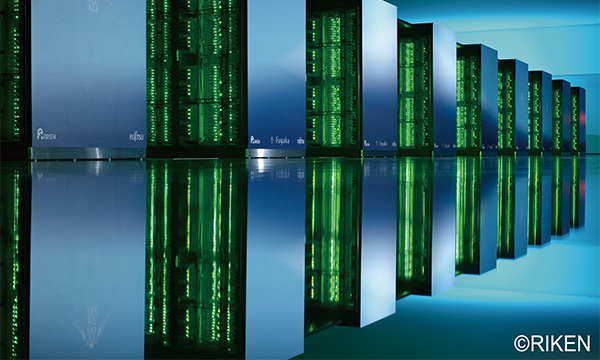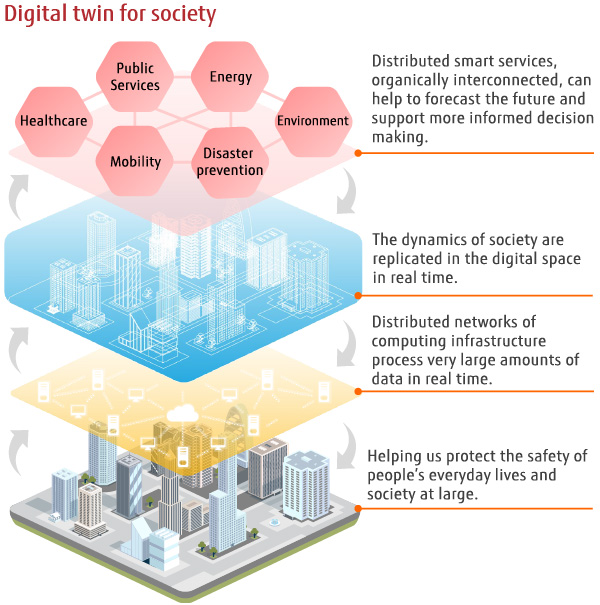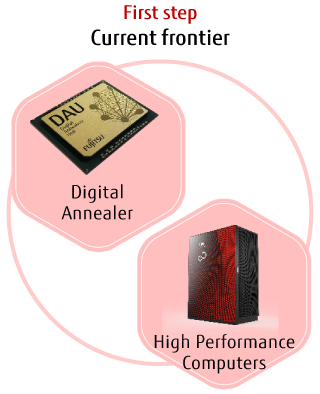Technology Vision
Fujitsu Technology and Service Vision 2021
In the Fujitsu Technology and Service Vision 2021 edition, we introduce five important trends that will shape the new world after the inflection point. We also explain how our commitment to responsible business will help to build a more sustainable world. We share future scenarios in specific focus areas and outline how technology innovations are already making these future scenarios a reality.
Technology has the power to help us solve the world’s most difficult challenges, transforming societies for the better. We introduce five exciting visions of technology innovation.

Making the impossible possible

Technology has the power to help us solve the world’s most difficult challenges, transforming societies for the better. Business and society will increasingly be driven by data and technology. The dynamics of the physical world can be projected in the digital space, and AI technology helps predict what may happen in the future. This empowers the creativity of people, ensuring the safety and security of our daily lives.
Fugaku, a supercomputer jointly developed by the Institute of Physical and Chemical Research (RIKEN) and Fujitsu, achieved four crowns in the world‘s supercomputer rankings twice in a row. Fugaku has already demonstrated its ultra-high-speed processing power in a large-scale simulation of the physical world as well as cancer gene network analysis using Fujitsu’s explainable AI technology.
Fujitsu also delivered the AI-Bridging Cloud Infrastructure (ABCI) for the National Institute of Advanced Industrial Science and Technology (AIST). The ABCI achieved the highest performance in the MLPerf HPC benchmark that measures large-scale machine learning processing. Our intention is to enable a wider community of researchers and organizations to use ultra-large computing platform like these and produce significantly positive impact on society. Furthermore, we hope photo-electronics convergence technology as well as quantum computers will deliver breakthroughs in the future.
We’ll continue to focus on developing technologies to make the previously impossible possible.
Human Centric Innovation

While technologies continue to advance, we also face their negative side effects. Can we trust the huge amounts of data continuously generated around the world? How can we find the right balance between protection of private data and its positive value for economy and society? Can we trust the judgements of AI? What kind of potential impact will AI and robotics technologies have on employment and human dignity?
Fujitsu is developing and implementing technology based on our human-centric principles. We set out the Fujitsu Group AI Commitment and established the Fujitsu Group External Advisory Committee on AI Ethics to ensure the safe and secure deployment of AI in society. We are collaborating with international organizations, contributing to the development of AI ethics guidelines. In addition, Fujitsu is developing digital trust technologies, to help use data for a better society while ensuring privacies.
To contribute to a trusted society that will continue for many generations, we create human centric innovation by bringing together people with data and physical things.
Technology vision
We’ll contribute to rebuilding trust and creating sustainability by realizing technology-based innovations with our partners.
Fujitsu Technology and Service Vision 2021 introduces five visions of technology innovation.
1. Borderless experience
Anytime, anywhere
The pandemic has accelerated a shift to a hybrid working model. Traditional lifestyle models defined by location, where people worked at offices and lived their private lives at home, is rapidly becoming a thing of the past. This shift is not just about work. Shopping, learning and many other things are also being disconnected from fixed locations. What kind of seamless experiences will be available in the future? How can this help us all live fuller lives?
Connected technologies are breaking the boundaries between physical and digital spaces, enabling new, human-centric, digital experiences. Digital experiences will be enhanced almost to a physical level, while physical experiences will be augmented by digital. Reality is no longer just one physical experience, or two distinct physical and digital experiences. People will be able to move flexibly between the different realities.
Human experience
Virtual Reality (VR) enhances digital experiences, while Augmented Reality (AR) brings digital experiences into a physical space.
5G and beyond
Ultra-high-speed, low-latency, multi-connection 5G technology and the subsequent beyond-5G/6G technology will connect people, things and data, enabling the transmission of massive amounts of video data and the creation of teleportation-like experiences.
Sense computing
Based on real-time data from sensors, AI technology understands a person’s contextual situation, reading emotions from their facial expressions and voices to deliver personalized experiences.

Impact on society

Inclusive experiences
We can create more inclusive experiences, for example by helping the elderly and people with disabilities to enjoy collaboration, leisure, shopping and traveling while staying at home.

Borderless collaboration
Mixed reality and 5G technologies will allow people to share a single collaboration space, regardless of their individual location, including offices, laboratories or on the move. This will open exciting new possibilities for joint research by talented people from all over the world, as well as concurrent engineering across a wide range of functions.
Our approach
Fujitsu is working with various partners to co-create innovative experiences using 5G technology. For example, in collaboration with Kwansei Gakuin University, we used 5G technology to trial off-site learning at an aquarium for students who were hospitalized. Children wearing head-mounted displays were able to observe giant whale sharks, with the virtual experience of swimming in the same aquarium waters.
We provide remote collaboration spaces where anyone can participate from anywhere. Team members can work together, virtually sharing the same space. We’re also enabling remote engineering work at a factory using 5G and VR technologies. We’ll continue to promote open innovation with partners, developing technologies that enable borderless lives.
2. Extended present
Prediction first
Previously, we have relied heavily on past experiences to create a view of the future, as if the future is an extension of the past. However, the pandemic and recent natural disasters have been unlike anything we had experienced before. What we need in this increasingly uncertain world is resilience, the ability to respond quickly to unexpected change.
What if technology could extend the present so that we can see into the future? We believe this ‘Prediction First’ approach will become a dominant style of business decision making.
The key is a large-scale digital twin, which projects the dynamics of society into a digital space. In order to forecast accurately what will happen in the next few minutes or hours, real-time data must be processed instantly. We need to digitize and capture the dynamics of people, organizations and whole environments. We have to process these ultra-large scale data sources while recognizing their complex inter-relations. This requires the integration of sensors both with low latency 5G and optical transmission networks and with the distributed computing infrastructures that can process data at high speeds.

The challenge is to increase network speed and capacity, while reducing power consumption. Photoelectric fusion technology is expected to provide a solution, enabling high-speed input and output of large amounts of data with very low power consumption.
Impact on society

Resilience to disasters
The high-precision simulation of how heavy rain causes floods can help to create a model for assessing potential damage. Using ever-changing, real-time data as a disaster unfolds, the model can help people make the best decisions and take the right actions, ultimately saving lives.

Safe and secure mobility
A mobility digital twin monitors real-time traffic and calibrates what may happen next. This can assist drivers, reducing congestion and preventing the occurrence of accidents.
Our approach
We are combining the ultra-fast large-scale computing power of supercomputers and cutting-edge AI technology. For example, Fugaku was used to simulate tsunami conditions, developing a high-quality AI model through rapid learning of high-resolution simulation data.
Using Fujitsu's real-time stream data processing technology, we’re developing a digital twin that will support next-generation mobility services. This can already process the data traffic from around one million connected cars.
We’re now enhancing the technology to enable a whole-city digital twin platform, capable of processing large-scale data from over 10 million connections.
Fujitsu supports IOWN initiative proposed by NTT. In April 2021, we agreed a strategic business alliance aimed at the realization of a sustainable digital society. We’re now working together to develop new photo-electronics convergence manufacturing technology, promoting the next-generation open network solutions required to realize a large-scale digital twin for society.
3. Human + Technology
AI that can make new discoveries
The progress of humankind is marked by a history of new discoveries. We have developed hypotheses to solve problems, created new knowledge in science and engineering through trial and error and delivered innovations that have transformed society. Without doubt, the creativity of people is the driving force behind these discoveries.
But what if technology could support and dramatically accelerate this discovery process? Deep learning technology can already find correlations of vast amounts of data that cannot be handled by humans. This kind of AI has enabled computer vision and natural language processing. However, current AI technologies are still not able to infer causal relationships. What we need is a new AI technology that finds causation, making hypotheses that lead to the validation of new discoveries.
Over the next 10 years, we expect human creativity to be augmented by technology, opening the way to new discoveries from data and breakthroughs that solve difficult problems. Creative collaboration between people and AI can be expected in many fields, enabling us to find how cancer is being caused by gene mutation and lifestyles, and an innovative way to develop new materials, for example. To achieve these, AI technology must be highly trusted and transparent so that people can use it with confidence.

What AI technology can do is expanding from recognizing images and languages out of data to inferring causal relationships between data and making new discoveries.
Impact on society
Personalized genomic medicine for cancer
In the future, AI technology will be able to analyze the entirety of human genomic information and infer causality. By combining related clinical data and analysis of lifestyles, it will be possible to help medical researchers identify the factors that cause specific cancers. Ultimately, AI technology will help clinicians find personalized treatments with the fewest side effects, contributing to the extension of healthy life expectancy for individual patients.

Our approach
Fujitsu has already achieved technology breakthroughs in the field of cancer genomic medicine in collaboration with leading universities and research institutions. We successfully demonstrated the world’s first explainable AI technology. We deployed Fujitsu's knowledge graph technology to map medical knowledge, using our deep learning technology to identify the genetic mutation and related factors that cause particular cancers. This technology will be applied to clinical medicine very soon.
Recently, Fujitsu calibrated a causal relationship between different types of colorectal cancer and approximately 300 related genes. From the data only, we succeeded in rediscovering the genes that were related with a particular type of colorectal cancer. We’ll continue to work on applying AI technology to infer causal relationships of the entire human genomic information, contributing to the advancement of cancer treatment through creative collaboration between medical professionals and AI technology.
4. Overcoming complexity
Solving difficult problems
There are many problems that are too complex for conventional computers to solve within a practical time. Extreme complexity can be found both in microscopic fields like invisible molecules as well as in macroscopic fields like the dynamics of whole cities.
For example, in order to develop new drugs for infectious diseases, it is necessary to find molecular compounds that have the potential of effectiveness against pathogens. However, it typically takes 4 to 6 years to search for these compounds using trial and error. Similarly, it takes many years to explore innovative materials. For example, how can we discover new materials that will improve the efficiency of solar power generation?
However, quantum computing technology is making rapid progress. Fujitsu’s Digital Annealer, a quantum-inspired computer, is the first step in the quantum era. We can use Digital Annealer to rapidly and accurately discover candidate compounds for middle-molecular drugs and help accelerate the drug discovery process. This can be combined by a supercomputer like Fugaku to simulate and identify the most likely molecular compounds. In the long term, gate-based quantum computers will be developed, achieving breakthroughs to solve even the most complex problems.

First step Current frontier
Digital Annealer can instantly solve complex combinatorial optimization problems that are difficult for conventional computers. For example, it can be used for optimizing urban traffic, or searching for molecular compounds in the drug discovery process. Combined with high performance computing, Digital Annealer helps solve real-world problems.

Next step Evolution of computing
Quantum computers are expected to start working on practical applications from 2030 onwards, enabling high-speed quantum mechanical simulations. Combined with high performance computing, this will bring breakthroughs in many areas, including the development of new materials.
Impact on society

Reducing CO2 emissions by developing new materials
Quantum computing technology is expected to accelerate the development of new materials supporting our decarbonization objectives. These potential new materials include more effective solar cells, catalysts for artificial photosynthesis and catalysts for synthesizing ammonia and hydrogen, for example.

Medical breakthroughs
Digital Annealer not only helps to accelerate the search for chemical compounds in the drug discovery process. It’s also proving to be effective in the field of radiation therapy for brain tumors, where it has exciting potential to extend healthy life expectancy.
Our approach
Fujitsu is collaborating with leading global organizations to build an ecosystem and deliver co-innovations. For example, in joint research with the University of Toronto, Digital Annealer was used to calibrate a large number of combinations of gamma radiation from different angles for the treatment of brain tumors and arteriovenous malformations. This enables clinicians to develop treatment plans in minutes instead of hours. This is expected to significantly reduce treatment time, reduce the dose of radiation and reduce the burden on patients.
Fujitsu has jointly set up a collaborative center with RIKEN to carry out research and development of hardware and software technologies, aiming to enable superconducting quantum computers. We’re also conducting joint research with Osaka University, focusing on the error-correction technology that is crucial for the development of quantum computers. In addition, Fujitsu is collaborating with leading international organizations. We are engaged with Quantum Benchmark to jointly research the error suppression technology. We’re also working with Delft University of Technology on the diamond spin method to explore the potential for greater scaling.
5. Regenerative society
Addressing systemic global issues
The world is facing difficult challenges such as decarbonization, industrial waste and food shortages. These are complex and systemic social problems across borders and industries. The efforts of individuals and individual organizations are of course important, but we cannot solve society-wide, global-scale problems purely by addressing small pieces of the big picture.
Circulating trusted data in the end-to-end extended ecosystems will help solve complex problems. Sharing of trusted public and industrial data, validated by independent organizations, can accelerate the co-creation of new value. Furthermore, information such as CO2 emissions at each stage of the value chain can be tokenized as intangible social value. These tokens can accompany the flow of products from producers to sellers and consumers. Through this process, organizations and consumers can transparently evaluate the intangible social value of products, helping them make transaction decisions and changing their behaviors to produce better outcomes for the environment and society.
The key for this process is the digital trust technology that ensures the trustworthiness of data. Global mutual authentication beyond countries and regions will also be required. Distributed ledger technology like Blockchain should evolve to support distributed platforms that not only support commercial and financial transactions but also the exchange of intangible social value.

Impact on society

Reduction of food loss and waste
Blockchain technology helps develop transparent food value chains, from producers to consumers, enhancing food safety as well as reducing food loss and waste.

Economy based on intangible value
We can imagine new token-based evaluation systems whereby intangible social value, such as CO2 emissions and compliance with regulations, is tokenized and distributed, contributing to the sustainability of the environment and society.
Our approach
Fujitsu’s connection chain technology can securely link different blockchains. Using this technology, we promote an open source software community called Hyperledger Cactus together with Accenture. We’re already working on research, development and implementation in collaboration with various organizations. We’ll continue to explore the development of new blockchain technologies in order to realize a reliable token economy, where not only money and ownership but also various intangible values can be exchanged.
We’ve developed a new digital trust management technology called Trust as a Service (TaaS) that will ensure the authenticity of business data exchanged between private and public organizations. The technology can verify when and by whom the data was created, and whether it has been tampered with, to ensure trusted data exchange. We’re also participating in the Japan Digital Trust Forum, contributing to the development of a common TaaS architecture and the verification of early use cases.
- Fujitsu and Accenture Collaboration Accelerates Reliable Blockchain Interoperability : Fujitsu Global (press release, May 15, 2020)
- Fujitsu Develops Digital Trust Management Technology to Ensure Authenticity of Business Data : Fujitsu Global (press release, October 6, 2020)
- Successful initiatives with our customers:[AB InBev]Beer production meets 21st century blockchain technology
Other articles of Fujitsu Technology and Service Vision 2021
- Making the impossible possible
- Human Centric Innovation
- Technology vision
- 1. Borderless experience
- 2. Extended present
- 3. Human + Technology
- 4. Overcoming complexity
- 5. Regenerative society












